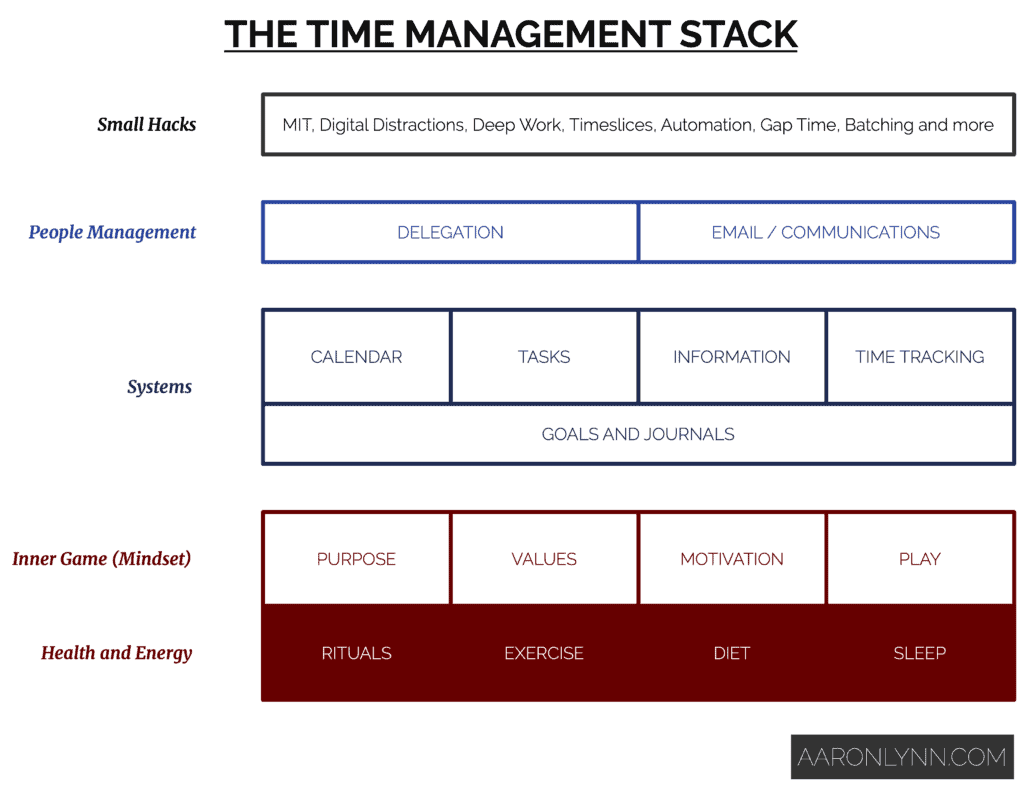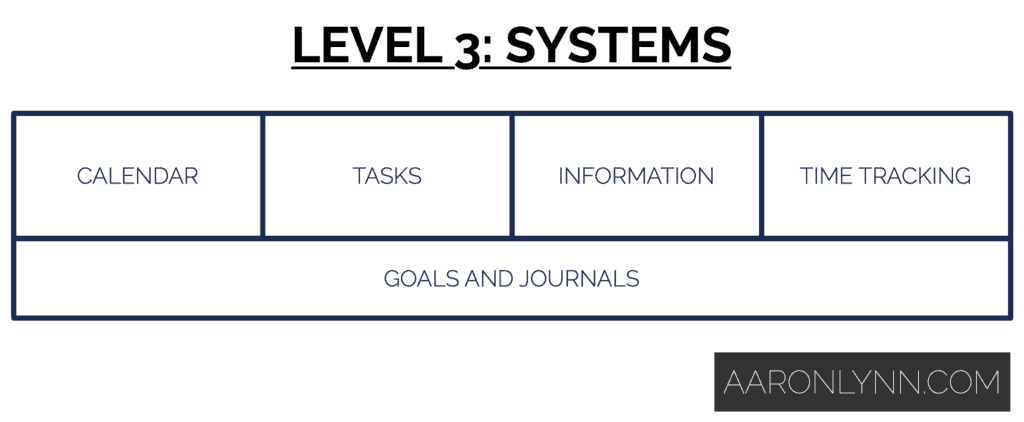
The Time Management Stack is a toolkit of systems, mindsets, principles and skills that help you utilise your time more effectively.
It is a subset of the Productivity Stack, with which it shares some parts.
Time is the most valuable resource that we have. Once time has passed, we cannot get it back.
And this makes time management critical for everyone, no matter what their life’s purpose is.

The Time Management Stack is a literal stack.
It starts with a foundation of health and energy, and builds upwards.
Let’s look at the stack in detail and see how it fits together.
Time Management Stack Level 1: Health and Energy
At the base of the time management stack is your health and energy. This is shared with the Productivity Stack.
Your health and energy is the foundation of your time management, because without a functioning physical body, you cannot do anything effectively.
The first part of your health and energy are your Rituals.
Rituals are sequences of habits that you do daily to put yourself into the right emotional states and head-spaces to be productive.
Think of them as the warm up and stretching you need to do, to access your stores of energy and physical capacity.
The second part is exercise, which is about building your body’s capacity for energy and living longer.1Gries, K. J., Raue U., Perikns, R. K., Lavin, K. M., Overstreet, B. S., D’Acquisto, L. J., Graham, B., Finch, W. H., Kaminsky, L. A., Trappe, T. A., Trappe, S. (2018). Cardiovascular and skeletal muscle health with lifelong exercise. Journal of Applied Physiology, 125(5), 1636-1645. doi:10.1152/japplphysiol.00174.2018.2Tucker, L. A. (2017). Physical activity and telomere length in U.S. men and women: An NHANES investigation. Preventive Medicine, 100, 145-151. doi:10.1016/j.ypmed.2017.04.027.
The third part is your diet, which runs on the principle of GIGO.
You can choose your metaphor here:
- Your diet as the high performance fuel you need to run your body, or
- Your body as a temple that cannot be worshipped at should it be defiled by junk.
The last part of your health and energy is your sleep.
Your body needs it. Your brain needs it. Your sanity needs it.
Sleep is the foundation of all physical energy.
A lot of time management (and other productivity) problems can actually be solved by just sleeping properly.
Time Management Stack Level 2: Inner Game and Mindset
The second level of the time management stack is your inner game or mindset.
This is the interplay of your purpose, values, beliefs and mental frameworks that help determine if you can utilise time effectively – or not.
It is also part of the Productivity Stack.
The first part of your inner game is your purpose.
Your purpose is the point of everything – why is it that you do what you do?
Without a strong and defined purpose, time management is moot.
The second part of your inner game is your values.
Your values are the high-level principles that guide how you act – your “default settings” so to speak.
Not all values are conducive with good time management. There is nothing wrong with that, so long as you have actively made that decision for yourself.
It is known that values simply are rather than being a conscious decision.
This is partially true.
If you know what your values are and decide that they are not conducive with what you want, you can decide to change them for the better.
The third part of your inner game for time management is your motivation.
If you are to be effective with your time you must be able to self-motivate.
Whether this is through small hacks, mindset changes or otherwise, you must be able to do it.
“Motivation” in this sense can be thought of as getting yourself to do things when you don’t really want to do them.
The last part of your inner game for time management is Play.
Whatever it is you do, there is no point doing it if it’s all hard work and no fun.
A well developed sense of play will also make everything seem easier, and also change your perception of how time passes.
Time Management Stack Level 3: Systems
The third level of the time management stack consists of your personal systems.
The “foundation” within your systems are your goals and journals.
Goals are mandatory for anyone looking to manage their time more effectively, for the same reason that purpose is: if you don’t have something worth managing, there is no point.
Goals consist of setting effective goals, and then knowing how to get them.
Journals are a system for tracking goals and other things in your life, from task to appointments, to thoughts to emotions to habits.
The main advantage of journals is that you can work across multiple timeframes and you always have a recorded history to refer back to and reflect upon.
Both goals and journals tell you what you need to focus on at a given time. They can also help you work out which goals to prioritise, so that you can achieve them in a rational and systemised manner.
The second part of your systems is your calendar and schedule and how you manage it.
This is simply the proper management of your schedule and appointments both with yourself and others.
The third part of your systems is your task management.
This is how you sort and manage your tasks and projects – the actions you need to take.
It also includes how to use frameworks like the Eisenhower Matrix or Getting Things Done to prioritise your tasks.
The fourth part of your systems is your information management.
We produce a lot of information nowadays.
We need a way to filter it, track it and file it away for future use.
Having effective information and document management helps with this.
The last part of your personal systems is time tracking.
I mentioned earlier that time is the only resource you can’t get back. So why aren’t you tracking it?
Everyone should be measuring the raw hours they spend doing things to get a real indication of where their time really goes.
Time Management Stack Level 4: People Management
The fourth level of the time management stack is People Management.
This may seem like an odd inclusion in the field of time management, but as human beings we live in societies and interact with each other – and use time to do so.
The first aspect of people management is delegation, or the ability to use other people’s time.
There are many opportunities to do this in the modern world.
The second aspect of people management is email/communication management, or how we handle other people’s attempts to use our time.
You need to be able to effectively triage and manage emails, DMs and calls.
This can be done through a clever mix of automation and prioritisation systems.
Time Management Stack Level 5: Small Hacks
The final and top layer of the time management stack are the “small hacks”.
The bottom four levels of the time management stack are much more important to get right in the long term.
These “small hacks” can be thought of as the ornamentation on top of your already solid foundation of effective time management.
They include:
- Most Important Tasks, which is a way for morning people to build a cumulative psychological advantage in tackling their hardest/most important work first thing, everyday.
- Handling destructive snacking and digital distractions.
- Deep work and single tasking, or the ability to get things done, with quality and one at a time.
- Timeslicing and flowtime, which utilises a timer to help you compartmentalise tasks and schedule regular breaks.
- Night/day before planning, which is exactly what it sounds like.
- Automation of all sorts. Automation is a form of building time assets.
- Gap time, or making the most of lost transit and waiting time.
- Batching, or reducing the costs of set up and teardown by doing lots of repetitions of the same thing together.
There are more “small hacks” than those listed. For example, solar flaring or the use of nootropics and stimulants.
Just remember that these are the finishes that build on an already solid and developed four levels of time management.
What To Do Next
This article is designed to serve as reference point to the entire time management stack.
Many of the parts of the stack already have guides up, and those are linked – you can take those and put them to work for you right away.
For everything else, grab a 100% free copy of Evolution below. It shows you how you can use systems like the Time Management Stack to live a better life in today’s world.
- Gries, K. J., Raue U., Perikns, R. K., Lavin, K. M., Overstreet, B. S., D’Acquisto, L. J., Graham, B., Finch, W. H., Kaminsky, L. A., Trappe, T. A., Trappe, S. (2018). Cardiovascular and skeletal muscle health with lifelong exercise. Journal of Applied Physiology, 125(5), 1636-1645. doi:10.1152/japplphysiol.00174.2018.
- Tucker, L. A. (2017). Physical activity and telomere length in U.S. men and women: An NHANES investigation. Preventive Medicine, 100, 145-151. doi:10.1016/j.ypmed.2017.04.027.
Photo by Patrick Fore.




